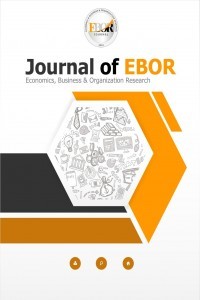CONTEMPORARY TRENDS IN THE MANAGEMENT OF INTERNATIONAL CONCERNS
Multi-entity Organization (concern), Parent Company, Subsidiary, Centralization, Decentralization, Corporate Functions, Flexibility
CONTEMPORARY TRENDS IN THE MANAGEMENT OF INTERNATIONAL CONCERNS
Multi-entity Organization (concern), Parent Company, Subsidiary, Centralization, Decentralization, Corporate Functions, Flexibility,
___
- Acemoglu, D., Aghion, P., Lelarge, C., van Reenen, J. & Zilibotti, F. (2007). Technology, information, and the decentralization of the firm. Quarterly Journal of Economics, 122: 1759-1799.
- Baum JAC, & Haveman H.A. (2020). Editors’ comments: the future of organizational theory. Acad Manag Rev, 45(2), pp. 268–272
- Bergeron, B. (2003). Essentials of Shared Services, John Wiley and Sons, New Jersey.
- Birkinshaw, J.M. (2018). How is technological change affecting the nature of the corporation? J Br Acad 6(s1), pp. 185–214
- Brilman J. (2002). Nowoczesne koncepcje i metody zarządzania, PWE, Warszawa
- Broszkiewicz A. (2008). Wpływ zagranicznych grup przemysłowych na funkcjonowanie nowo utworzonych spółek zależnych w Polsce – wyniki badań, Przegląd Organizacji 4/2008, Warszawa
- Goold M. Campbell A. (2003). Structured Networks: How to create enough but not too much structurein your organization, Ashridge Strategic Management Centre
- Hernandez V. & Pedersen T. (2017). Global value chain configuration: a review and research agenda. BRQ Bus Res Q 20(2), pp.137–150
- Iansiti, M, & Lakhani, K.R. (2020). Competing in the age of AI: strategy and leadership when algorithms and networks runthe world, Harvard Business Review Press, Boston
- Keuper F., Oecking Ch. (Hrsg.) (2008). Corporate Shared Services, Bereitstellung von Dienstleistungen im Konzern, Springer Gabler.
- Kleinbaum AM, & Stuart TE. (2011). Inside the Black Box of the Corporate Staff: An Exploratory Analysis Through the Lens of E-Mail Networks, Tuck School of Business Working Paper. Tuck School of Business Dartmouth
- Kraśnik J. (2012). Zmiany struktur organizacyjnych przedsiębiorstw w procesie internacjonalizacji, Wydawnictwo Uniwersytetu w Poznaniu, Poznań
- Kreft Z. & Karwan M. (2003). Centralizacja i decentralizacja uprawnień decyzyjnych w holdingu – dylematy lokalizacyjne, Przegląd Organizacji, nr 4
- Krupski R., (2008). Rodzaje i podstawowe mechanizmy elastyczności, w: R. Krupski (red.), Elastyczność organizacji, Wydawnictwo Uniwersytetu Ekonomicznego we Wrocławiu, Wrocław, s.7-13
- Krupski R. (2005). Elastyczność struktur organizacyjnych, w: J. Stankiewicz (red.), Oblicza współczesnego zarządzania organizacją, Oficyna Wydawnicza Uniwersytetu Zielonogórskiego, Zielona Góra.
- Kunisch S., Menz M. & Collis D., (2020). Corporate headquarters in the twenty‑first century: an organization design perspective, Journal of Organization Design, 9:22, pp.1-32
- Kunisch S., Müller – Stewens G. & Campbell A. (12.2014). Whay corporate Functions Stumble, HarwagdBusiness Review, https://hbr.org/2014/12/why-corporate-functions-stumble
- Lachiewicz S. & Zakrzewska – Bielawska A. (2010). Kierunki zmian w strukturach organizacyjnych przedsiębiorstw przemysłowych, ACTA UNIVERSITATIS LODZIENSIS, FOLIA OECONOMICA 234, Łódź Menz M, Kunisch S. & Collis D.J., (2015). The corporate headquarters in the contemporary corporation: advancing a multimarketfirm perspective. Acad Manag Ann 9(1):633–714
- Neilson G.L. & Wulf J. (2012). How Many Direct Reports? Harvard Business Review, nr 4
- Osbert – Pociecha G., (2008). Określenia, definicje, problemy, w: R. Krupski (red.), Elastyczność organizacji, Wydawnictwo Uniwersytetu Ekonomicznego we Wrocławiu, Wrocław
- Quinn B., Cooke R. & Kris A. (2000). Shared services: mining for corporate gold, Financial Times/Prentice Hall, London.
- Sobotkiewicz D. (2005). Samodzielność decyzyjna krajowych oddziałów przedsiębiorstw zagranicznych w Polsce w zakresie marketingu, rozprawa doktorska, AE Wrocław
- Stępień B. (2009). Instytucjonalne uwarunkowania działalności przedsiębiorstw międzynarodowych, Wydawnictwo Uniwersytetu Ekonomicznego w Poznaniu, Poznań
- Listwan T., Stor M. (red.),(2008). Zarządzanie kadrą menedżerską w organizacjach międzynarodowych w Polsce, Wydawnictwo UE Wrocław, Wrocław
- Strange. R, Humphrey. J., (2019). What lies between market and hierarchy? Insights from internalization theory and global value chain theory. J Int Bus Stud 50(8), pp. 1401–1413
- Theisen M.R., (2000). Der Konzern, Schaffer-Poeschel Verlag, Stuttgart
- Werr, A., Blomberg, J. & Lӧwstedt, J. (2009). Gainining external knowledge – boundaries in managers knowledge relations, Journal of Knowledge management , Volume 13, No. 6. pp. 448-463.
- Wang S. & Wang H. (2007). Shared services beyond sourcing the back offices: Organizational design, Human Systems Management, Volume 26, Number 4, IOS Press.
- Zając Cz. (2012). Zarządzanie zasobami ludzkimi w grupach kapitałowych, PWE, Warszawa
- Yayın Aralığı: Yılda 2 Sayı
- Başlangıç: 2019
- Yayıncı: Mehmet GÖKERİK
Charitha Harshani PERERA, Rajkishore NAYAK, Long Thang Van NGUYEN
EXPLORING THE COMMUNICATION EXPECTATIONS OF HEALTH CARE WORKERS: EMPIRICAL EVIDENCE FROM TURKEY
Hayda Abu HASAN, Sathiswaran UTHAMAPUTHRAN
CONTEMPORARY TRENDS IN THE MANAGEMENT OF INTERNATIONAL CONCERNS
INNOVATIVE PREDICTION OF COMMUNICATION AGENCIES
Michal KUBOVİCS, Anna ZAUŠKOVÁ
MEASURING EFFICIENCY OF WORKING CAPITAL MANAGEMENT: INDEX METHOD
NEW TECHNOLOGIES AND NEW SERVICE MODELS IN THE ITALIAN DIGITAL HEALTH SECTOR
Antonella MONDA, Antonio BOTTI, Rosangela FEOLA, Ricky CELENTA
SUSTAINABILITY, DIGITAL TECHNOLOGIES AND FIRM’S PERFORMANCE: AN EMPIRICAL ANALYSIS
Grazia DICUONZO, Francesca DONOFRIO, Simona RANALDO, Vittorio DELL’ATTI
